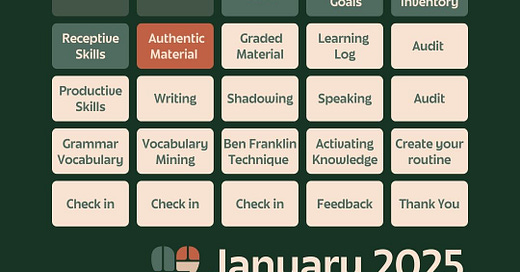Throughout the month of January, I’ll be sharing quick posts to help you build a sustainable and joyful language learning practice. This series, Fresh Foundations, is all about actionable steps you can take in just 15-30 minutes a day to create a language learning routine that works for you.
If that sounds like something you’re ready for, let’s get into the activity for Day 5!
When it comes to improving your language skills, authentic materials can make a world of difference. These are real-world resources like podcasts, blogs, or news articles that native speakers use every day. They expose you to natural vocabulary, culture, and accents that you won’t always find in textbooks.
Types of Materials and Where to Find Them
Here’s a quick guide to get started:
Audio:
Songs (find ones with lyrics available!)
Podcasts on topics you love. Look for podcasts with available transcripts.
Streaming radio (better than podcasts because you’ll hear news bulletins and ads that give you access to other a wide range of genres).
Video:
Children’s cartoons (great for simple vocabulary).
Sitcoms (light, funny, and short).
Streaming series and films.
News, documentaries or TEDtalks with transcripts or subtitles.
YouTube videos, short-form videos on social media, etc.
Text:
Blogs and articles on Substack. Obviously.
Social media captions (great source of colloquial phrases)
Newspapers or journalism. If you’re learning English, Brazilian Portuguese, French or Indonesian, I recommend The Conversation.
Newsletters from newspapers in your target language. Sometimes these are free!
Books. For me, nothing beats reading a physical book in my target language. It’s so satisfying to see your physical progress as the bookmark advances. Don’t shy away from “beach read” type material.
Controversial opinion!
I know a lot of people like to read children’s picture books. I don’t usually recommend them for beginners because they aren’t necessarily easier. Often, they use idiomatic language and rhymes which aren’t necessarily common in everyday speech.
Magazines, especially physical ones. These usually include different types of articles, cover a wide range of subtopics and have ads that use short slogans with images. Very versatile!
How to Make Authentic Material Comprehensible
Authentic materials are a fantastic resource, but they can sometimes feel overwhelming. The trick is to make them work for you by applying strategies that keep the content just challenging enough.
Remember our post about comprehensible input and i+1? The idea is to engage with material that’s slightly above your current level- enough to stretch you, but not so much that it feels impossible.
Strategies for Understanding Authentic Material
Use Contextual Clues:
Look for hints like images, tone, or familiar phrases to piece together meaning. For example, subtitles in a video or a picture in a blog post can provide vital clues.Activate Prior Knowledge:
What do you already know about the topic? Familiarity with a subject makes it easier to predict meaning and follow along.Repetition is Key:
Don’t be afraid to re-watch, re-listen, or re-read. Each time, you’ll catch something new, and the material will feel easier.Focus on the Gist:
Don’t aim for 100% comprehension. Instead, focus on understanding the main idea, even if some words remain a mystery.Modify Your Objectives:
Sometimes it’s not about understanding everything. Instead, focus on specific goals like getting the gist, practicing new vocabulary, or preparing to explain the content to someone else (in your first or target language).
Modifying the Material
Sometimes you’ll need to adjust the material to make it more accessible:
Shorten It:
Choose shorter videos, articles, or song snippets instead of tackling something long.
Pick Familiar Topics:
Engage with content you already enjoy and know about. Love cooking? Start with recipes or food videos in your target language. Watch your favorite films dubbed in your target language.
Get Support:
Use subtitles, transcripts, or dictionaries. Tools like ReadLang let you look up words instantly while reading online.
Compare Texts:
Find a version of the material in your first language. Comparing the two can help clarify meaning. Sometimes newspapers have editions in other languages, so you can feel confident you’re using a reliable translation.
AI Tools Are Your Friend:
Summarize or simplify texts using AI tools to give you a clearer idea of what’s being discussed.
Adjust the Speed:
Slow down audio or video playback for better comprehension. Most platforms offer this feature.
Your Task for Today
Find one audio, video, or text source that excites you and commit to using it as your authentic material source for the rest of the month.
Bookmark websites.
Order books.
Create a playlist.
Add the links to your Notion or download this PDF and keep track there. 😊
The more you engage with authentic materials, the more confident and connected you’ll feel with your target language. Join the chat to share your recommendations!
If this has resonated with you, hit that like button or share with another language learner who you think would love to build Fresh Foundations in 2025.
See you tomorrow for Day 6!






